From Vineyard to the Sea, along the Cammino Minerario di Santa Barbara and the Lands of Carignano
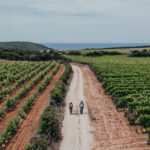
In the far southwest of Sardinia, the second-largest island in the Mediterranean, travelers can now embark on the Cammino Minerario di Santa Barbara (CMSB), a 500-kilometer route divided into 30 stages. Located just 70 kilometers from Cagliari (the regional capital with an international airport), the trail connects the main towns of the Sulcis region, including Iglesias, Carbonia, Sant’Antioco, and Sant’Anna Arresi. Referred to as “pilgrims,” walkers retrace the paths once taken by miners, shepherds, fishermen, and farmers. Alongside ancient mines and vineyards, the area also offers some of Sardinia’s most striking beaches, with long stretches of sand and crystal-clear waters. The trail blends history, spirituality, and nature, while revealing the identity of Sulcis, one of the island’s most authentic and layered territories.
An Early Test Walk
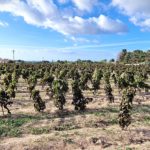
In September, together with a limited group of selected colleagues, we had the unique opportunity to experience this trail almost as a preview. What struck us most was the remarkable diversity and coherence of the experience. Diversity is often promised in tourism projects, but rarely delivered with such authenticity and consistency. Along the Cammino Minerario di Santa Barbara, everything felt naturally interwoven—from the changing landscapes and historic villages to the local food, ancient mines, and distinctive wines. Each element formed part of a unified and richly layered territory, offering an immersive sense of place that was both genuine and deeply moving. Above all, what truly stood out was the passion and dedication of the local people behind the project. From museum guides to vineyard workers, from cooperative leaders to volunteers, each person conveyed a profound connection to the land and a clear sense of what Sulcis represents. Their knowledge, warmth, and pride gave depth to every encounter, turning the journey into a truly human and emotional experience.
From Vineyards to the Sea
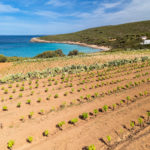
An immersive journey began among vineyards overlooking the coast, with an introduction to Carignano del Sulcis and its role in shaping local identity. Tastings and meals in the open air highlighted how deeply wine is linked to this land. Later, walks across the island of Sant’Antioco revealed quiet paths, gentle slopes, and seascapes, before evenings spent by the harbor with traditional food and local wines. The following day took us inland, through rolling hills and historic villages, along trails lined with vineyards and Mediterranean scrub. Lunch was built around the symbolic “Pilgrim’s Menu,” connecting hospitality to tradition. In the evening, the focus shifted to the sea again: the historic tonnara (tuna fishery) of Portoscuso, founded in the late 1500s, where tuna has long shaped local culture. Here, wine and food came together in striking harmony, with different cuts and recipes of tuna paired with ambitions and expertise to rosé and different red versions of Carignano, underlining the depth and versatility of both.
Into the Mines
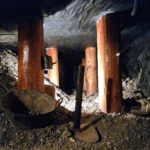
The experience culminated at the Great Mine of Serbariu, once a center of coal extraction. Stepping inside was moving. Even with clean air, normal light, and sound effects reduced six times, the atmosphere was powerful. It was enough to imagine what miners truly endured: dust, darkness, noise, and at times tunnels only 50–60 cm high. This encounter left a lasting impression, reminding us that Sulcis’ beauty is inseparable from its hardships.
The Wine Connection

To delve deeper into the local wine excellence: Carignano is a challenging grape variety Highly productive and naturally vigorous, it requires careful management in the vineyard especially to reduce yields. One risk is a touch of bitterness on the finish, yet in Sulcis this becomes a defining trait, integrated and elegant rather than a flaw.What makes it work here are unique conditions: sandy soils that allow ungrafted vines; old bush-trained vineyards with naturally low yields well integrated into the Mediterranean climate and the steady mistral winds, essential for a late-ripening variety traditionally harvested in mid-October (although climate change is shaking things). Together, these factors produce dense, characterful wines that remain contemporary in style. The common thread is always that slightly bitter finale—balanced, persistent, versatile and unmistakably Carignano del Sulcis which, what’s more, perfectly works with food.Recognized as a DOC since 1977, Carignano del Sulcis comes in different styles: dry reds, riservas, and passito versions. Moreover, the rosé are particularly worth noting—often deeply colored thanks to the natural color intensity of the grape, with marked personality and more sapidity than freshness. They are highly gastronomic wines, pairing beautifully with both land and sea dishes.
The Food Connection
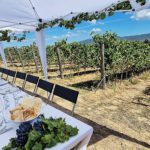
Food is an equally powerful guide through Sulcis. Despite being an island, meat dishes are central here: the maialetto (suckling pig), tasted in more than one version, is a staple of festive tables. Cheese plays a key role too—especially the much-loved pecorino of Sardinia, which stands apart from every other in Italy for its character and intensity. Fresh ricotta is equally important, used both in savory recipes and in desserts. Handmade pasta, often filled, anchors family cooking, while along the coast tuna and fish define local identity. Mussels are another pride of the island and proposed often as a specialty Sulcis. At the same time, the cuisine keeps memory of “poor” dishes and peasant frugality—like fried bread, a creative way to avoid waste. This blend of land and sea, of richness and simplicity, gives Sulcis a gastronomic identity as layered as its landscape—always authentic, always tied to tradition.
A Complete Journey
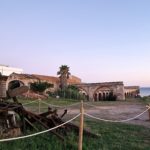
The Cammino Minerario di Santa Barbara is more than just a hike. It’s wine tastings by the sea, Carignano vineyards shaped by the mistral wind, ungrafted old vines, archaeological sites, tuna fisheries, nuraghi, medieval churches, and the proud, passionate voices of the people who call this land home. It’s a journey through hardship and beauty, history and revival—an immersive experience that linger